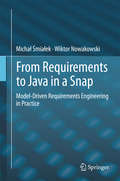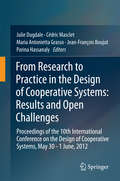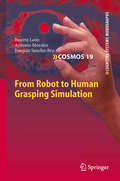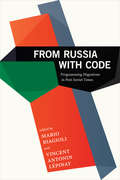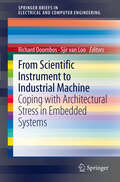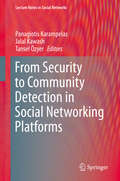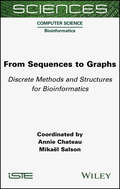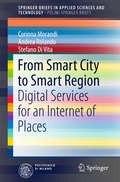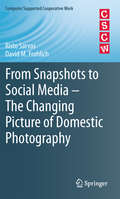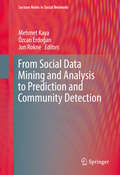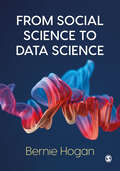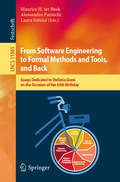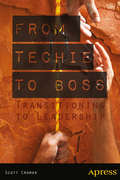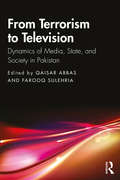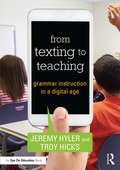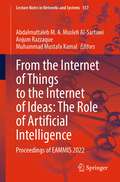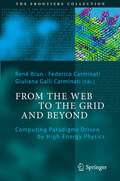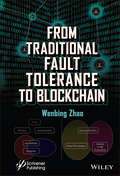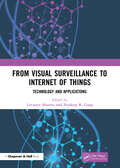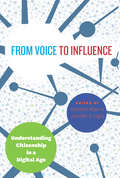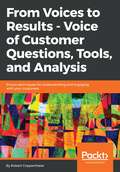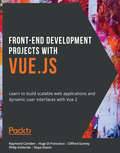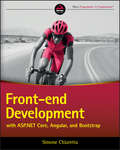- Table View
- List View
From Requirements to Java in a Snap
by Michał Śmiałek Wiktor NowakowskiThis book provides a coherent methodology for Model-Driven Requirements Engineering which stresses the systematic treatment of requirements within the realm of modelling and model transformations. The underlying basic assumption is that detailed requirements models are used as first-class artefacts playing a direct role in constructing software. To this end, the book presents the Requirements Specification Language (RSL) that allows precision and formality, which eventually permits automation of the process of turning requirements into a working system by applying model transformations and code generation to RSL. The book is structured in eight chapters. The first two chapters present the main concepts and give an introduction to requirements modelling in RSL. The next two chapters concentrate on presenting RSL in a formal way, suitable for automated processing. Subsequently, chapters 5 and 6 concentrate on model transformations with the emphasis on those involving RSL and UML. Finally, chapters 7 and 8 provide a summary in the form of a systematic methodology with a comprehensive case study. Presenting technical details of requirements modelling and model transformations for requirements, this book is of interest to researchers, graduate students and advanced practitioners from industry. While researchers will benefit from the latest results and possible research directions in MDRE, students and practitioners can exploit the presented information and practical techniques in several areas, including requirements engineering, architectural design, software language construction and model transformation. Together with a tool suite available online, the book supplies the reader with what it promises: the means to get from requirements to code "in a snap".
From Research to Practice in the Design of Cooperative Systems: Results and Open Challenges
by Parina Hassanaly Maria Antonietta Grasso Jean-François Boujut Cédric Masclet Julie DugdaleCOOP 2012 is the tenth COOP conference, marking twenty years from the first conference in 1992. In this special anniversary edition we asked researchers and practitioners to reflect on what have been the successes and the failures in designing cooperative systems, and what challenges still need to be addressed. We have come a long way in understanding the intricacies of cooperation and in designing systems that support work practices and collective activities. These advances would not have been possible without the concerted effort of contributions from a plethora of domains including CSCW, HCI, Information Systems, Knowledge Engineering, Multi-agent systems, organizational and management sciences, sociology, psychology, anthropology, ergonomics, linguistics, etc. The COOP community is going from strength to strength in developing new technologies, advancing and proposing new methodological approaches, and forging theories.
From Robot to Human Grasping Simulation
by Beatriz León Antonio Morales Joaquín Sancho-BruThe human hand and its dexterity in grasping and manipulating objects are some of the hallmarks of the human species. For years, anatomic and biomechanical studies have deepened the understanding of the human hand's functioning and, in parallel, the robotics community has been working on the design of robotic hands capable of manipulating objects with a performance similar to that of the human hand. However, although many researchers have partially studied various aspects, to date there has been no comprehensive characterization of the human hand's function for grasping and manipulation of everyday life objects. This monograph explores the hypothesis that the confluence of both scientific fields, the biomechanical study of the human hand and the analysis of robotic manipulation of objects, would greatly benefit and advance both disciplines through simulation. Therefore, in this book, the current knowledge of robotics and biomechanics guides the design and implementation of a simulation framework focused on manipulation interactions that allows the study of the grasp through simulation. As a result, a valuable framework for the study of the grasp, with relevant applications in several fields such as robotics, biomechanics, ergonomics, rehabilitation and medicine, has been made available to these communities.
From Russia with Code: Programming Migrations in Post-Soviet Times
by Mario Biagioli Vincent Antonin LépinayWhile Russian computer scientists are notorious for their interference in the 2016 US presidential election, they are ubiquitous on Wall Street and coveted by international IT firms and often perceive themselves as the present manifestation of the past glory of Soviet scientific prowess. Drawing on over three hundred in-depth interviews, the contributors to From Russia with Code trace the practices, education, careers, networks, migrations, and lives of Russian IT professionals at home and abroad, showing how they function as key figures in the tense political and ideological environment of technological innovation in post-Soviet Russia. Among other topics, they analyze coders' creation of both transnational communities and local networks of political activists; Moscow's use of IT funding to control peripheral regions; brain drain and the experiences of coders living abroad in the United Kingdom, United States, Israel, and Finland; and the possible meanings of Russian computing systems in a heterogeneous nation and industry. Highlighting the centrality of computer scientists to post-Soviet economic mobilization in Russia, the contributors offer new insights into the difficulties through which a new entrepreneurial culture emerges in a rapidly changing world. Contributors. Irina Antoschyuk, Mario Biagioli, Ksenia Ermoshina, Marina Fedorova, Andrey Indukaev, Alina Kontareva, Diana Kurkovsky, Vincent Lépinay, Alexandra Masalskaya, Daria Savchenko, Liubava Shatokhina, Alexandra Simonova, Ksenia Tatarchenko, Zinaida Vasilyeva, Dimitrii Zhikharevich
From scientific instrument to industrial machine
by Sjir Van Loo Richard DoornbosArchitectural stress is the inability of a system design to respond to new market demands. It is an important yet often concealed issue in high tech systems. In From scientific instrument to industrial machine, we look at the phenomenon of architectural stress in embedded systems in the context of a transmission electron microscope system built by FEI Company. Traditionally, transmission electron microscopes are manually operated scientific instruments, but they also have enormous potential for use in industrial applications. However, this new market has quite different characteristics. There are strong demands for cost-effective analysis, accurate and precise measurements, and ease-of-use. These demands can be translated into new system qualities, e.g. reliability, predictability and high throughput, as well as new functions, e.g. automation of electron microscopic analyses, automated focusing and positioning functions. From scientific instrument to industrial machine takes a pragmatic approach to the problem of architectural stress. In particular, it describes the outcomes of the Condor project, a joint endeavour by a consortium of industrial and academic partners. In this collaboration an integrated approach was essential to successfully combine various scientific results and show the first steps towards a new direction. System modelling and prototyping were the key techniques to develop better understanding and innovative solutions to the problems associated with architectural stress. From scientific instruments to industrial machine is targeted mainly at industrial practitioners, in particular system architects and engineers working on high tech systems. It can therefore be read without particular knowledge of electron microscope systems or microscopic applications. The book forms a bridge between academic and applied science, and high tech industrial practice. By showing the approaches and solutions developed for the electron microscope, it is hoped that system designers will gain some insights in how to deal with architectural stress in similar challenges in the high tech industry.
From Security to Community Detection in Social Networking Platforms (Lecture Notes in Social Networks)
by Jalal Kawash Panagiotis Karampelas Tansel ÖzyerThis book focuses on novel and state-of-the-art scientific work in the area of detection and prediction techniques using information found generally in graphs and particularly in social networks. Community detection techniques are presented in diverse contexts and for different applications while prediction methods for structured and unstructured data are applied to a variety of fields such as financial systems, security forums, and social networks. The rest of the book focuses on graph-based techniques for data analysis such as graph clustering and edge sampling. The research presented in this volume was selected based on solid reviews from the IEEE/ACM International Conference on Advances in Social Networks, Analysis, and Mining (ASONAM '17). Chapters were then improved and extended substantially, and the final versions were rigorously reviewed and revised to meet the series standards. This book will appeal to practitioners, researchers and students in the field.
From Sequences to Graphs: Discrete Methods and Structures for Bioinformatics
by Annie Chateau Mikaël SalsonIn order to study living organisms, scientists not only study them at an overall macroscopic scale but also on a more detailed microscopic scale. This observation, pushed to its limits, consists of investigating the very center of each cell, where we find the molecules that determine the way it functions: DNA (deoxyribonucleic acid) and RNA (ribonucleic acid). In an organism, DNA carries the genetic information, which is called the genome. It is represented as four-letter sequences using the letters A, C, G and T; based on these sequences, computer methods described in this book can answer fundamental questions in bioinformatics. This book explores how to quickly find sequences of a few hundred nucleotides within a genome that may be made up of several billion, how to compare those sequences and how to reconstruct the complete sequence of a genome. It also discusses the problems of identifying bacteria in a given environment and predicting the structure of RNA based on its sequence.
From Smart City to Smart Region
by Corinna Morandi Andrea Rolando Stefano Di VitaThis book offers a fascinating exploration of the relationship between information and communication technologies (ICTs) and spatial planning, expanding the concept of "urban smartness" from the usual scale of buildings or urban projects to the regional dimension. In particular, it presents the outcomes of research undertaken at Politecnico di Milano, in collaboration with Telecom Italia, that had three principal goals: to investigate the use of ICTs for the representation, promotion, management, and dissemination of an integrated system of services; to explore the spatial impacts of digital services at different scales (regional, urban, local); and to understand how a system of mobile services can encourage new spatial uses and new collective behavior in the quest for better spatial quality of places. Useful critical analysis of international case studies is also included with the aim of verifying the opportunities afforded by new digital services not only to improve the urban efficiency but also to foster the evolution of urban communities through enhancement of the public realm. The book will be a source of valuable insights for both scholars and local administrators and operators involved in smart city projects.
From Snapshots to Social Media - The Changing Picture of Domestic Photography
by Risto Sarvas David M. FrohlichFrom Snapshots to Social Media describes the history and future of domestic photography as mediated by technological change. Domestic photography refers to the culture of ordinary people capturing, sharing and using photographs, and is in a particular state of flux today as photos go digital. The book argues that this digital era is the third major chapter in the 170 year history of the area; following the portrait and Kodak eras of the past. History shows that despite huge changes in photographic technology and the way it has been sold, people continue to use photographs to improve memory, support communication and reinforce identity. The future will involve a shift in the balance of these core activities and a replacement of the family album with various multimedia archives for individuals, families and communities. This raises a number of issues that should be taken into account when designing new technologies and business services in this area, including: the ownership and privacy of content, multimedia standards, home ICT infrastructure, and younger and older users of images. The book is a must for designers and engineers of imaging technology and social media who want a better understanding of the history of domestic photography in order to shape its future. It will also be of value to students and researchers in science and technology studies and visual culture, as a fascinating case study of the evolving use of photographs and photographic technology in Western society.
From Social Data Mining and Analysis to Prediction and Community Detection
by Mehmet Kaya Özcan Erdoǧan Jon RokneThis book presents the state-of-the-art in various aspects of analysis and mining of online social networks. Within the broader context of online social networks, it focuses on important and upcoming topics of social network analysis and mining such as the latest in sentiment trends research and a variety of techniques for community detection and analysis. The book collects chapters that are expanded versions of the best papers presented at the IEEE/ACM International Conference on Advances in Social Networks Analysis and Mining (ASONAM'2015), which was held in Paris, France in August 2015. All papers have been peer reviewed and checked carefully for overlap with the literature. The book will appeal to students and researchers in social network analysis/mining and machine learning.
From Social Science to Data Science: Key Data Collection and Analysis Skills in Python
by Bernie HoganFrom Social Science to Data Science is a fundamental guide to scaling up and advancing your programming skills in Python. From beginning to end, this book will enable you to understand merging, accessing, cleaning and interpreting data whilst gaining a deeper understanding into computational techniques and seeing the bigger picture. With key features such as tables, figures, step-by-step instruction and explanations giving a wider context, Hogan presents a clear and concise analysis on key data collection and skills in Python.
From Social Science to Data Science: Key Data Collection and Analysis Skills in Python
by Bernie HoganFrom Social Science to Data Science is a fundamental guide to scaling up and advancing your programming skills in Python. From beginning to end, this book will enable you to understand merging, accessing, cleaning and interpreting data whilst gaining a deeper understanding into computational techniques and seeing the bigger picture. With key features such as tables, figures, step-by-step instruction and explanations giving a wider context, Hogan presents a clear and concise analysis on key data collection and skills in Python.
From Software Engineering to Formal Methods and Tools, and Back: Essays Dedicated to Stefania Gnesi on the Occasion of Her 65th Birthday (Lecture Notes in Computer Science #11865)
by Maurice H. ter Beek Alessandro Fantechi Laura SeminiThis volume was published in honor of Stefania Gnesi’s 65th birthday. The Festschrift volume contains 32 papers written by close collaborators and friends of Stefania and was presented to her on October 8, 2019 one-day colloquium held in Porto, Portugal, The Festschrift consists of eight sections, seven of which reflect the main research areas to which Stefania has contributed. Following a survey of Stefania's legacy in research and a homage by her thesis supervisor, these seven sections are ordered according to Stefania's life cycle in research, from software engineering to formal methods and tools, and back: Software Engineering; Formal Methods and Tools; Requirements Engineering; Natural Language Processing; Software Product Lines; Formal Verification; and Applications.
From Techie to Boss: Transitioning to Leadership
by David Jacobs Scott CromarFrom Techie to Boss teaches technical people who are making or mulling the transition from team player to team leader all the management techniques and soft leadership skills they never needed before-but need now, pronto. Veteran team lead and project manager Scott Cromar lays out the classical management training course, but stripped down to precisely the essentials that techies need to start managing on the fly. He gets it that a front-line techie getting a field promotion to team leader just doesn't have the time to wade through an MBA textbook bulging with irrelevant material. The author appreciates how you got to the place where you need this book. Management tapped you instead of some experienced manager from the outside because you know the technical challenges, company culture, and team players better than anyone else: you're ready to hit the ground running. But the skills that make you an excellent techie are not sufficient to make you a successful manager. The rules of your world have abruptly changed. You will now be judged not by your puzzle-solving elegance but by how effectively your team contributes to the organization's bottom line. From Techie to Boss shows you how to translate and adapt the analytic skills that made you an outstanding techie to your new responsibilities as a technical manager. Even more crucially, this book teaches you a whole new set of interpersonal, organizational, and metrical skills you never needed before, but without which you cannot succeed as a manager.
From Terrorism to Television: Dynamics of Media, State, and Society in Pakistan
by Qaisar AbbasThis book unpacks the media dynamics within the socio-cultural, political, and economic context of Pakistan. It provides an in-depth, critical, and scholarly discussion of contemporary issues such as media, state, and democracy in Pakistan; freedom of expression in Pakistani journalism; Balochistan as a blind spot in mainstream newspapers; media control by state institutions; women and media discourses; TV talk shows and coverage of Kashmir; feminist narrative and media images of Malala Yousufzai and Mukhtaran Mai; jihad on screen; and Osama bin Laden’s death on screen, to understand the relation between media and terrorism. The book covers diverse media types including TV, radio, newspapers, print media, films, documentary, stage performance, and social media. Detailed, interdisciplinary, analytical, and with original perspectives from journalists as well as academics, this volume will be useful to scholars and researchers of media studies, Pakistan studies, politics and international affairs, military and terrorism studies, journalism and communication studies, and South Asian studies. It will also interest general readers, policy makers, and those interested in global journalism, mass media, and freedom of expression.
From Texting to Teaching: Grammar Instruction in a Digital Age
by Jeremy Hyler Troy HicksDon’t blame technology for poor student grammar; instead, use technology intentionally to reach students and actually improve their writing! In this practical book, bestselling authors Jeremy Hyler and Troy Hicks reveal how digital tools and social media – a natural part of students’ lives – can make grammar instruction more authentic, relevant, and effective in today’s world. Topics Covered: Teaching students to code switch and differentiate between formal and informal sentence styles Using flipped lessons to teach the parts of speech and help students build their own grammar guides Enlivening vocabulary instruction with student-produced video Helping students master capitalization and punctuation in different digital contexts Each chapter contains examples, screenshots, and instructions to help you implement the ideas. With the strategies in this book, you can empower students to become better writers with the tools they already love and use daily. Additional resources and links are available on the book’s companion wiki site: textingtoteaching.wikispaces.com
From the Internet of Things to the Internet of Ideas: Proceedings of EAMMIS 2022 (Lecture Notes in Networks and Systems #557)
by Abdalmuttaleb M. A. Musleh Al-Sartawi Anjum Razzaque Muhammad Mustafa KamalThis book shows latest research on the role Artificial inelegance in enabling IoT to evoke IoI, and how IoI flourish inside technologies like social media platforms, social networks: communities of practice/interest, to assure a globally sustainable unit where humans integrate with machines to collaboratively share ideas and solve complex problems. Such a book holds several benefits. It will reveal theoretical practical, and managerial implications through discussions that will embrace a wide array of technologies focused on the role of AI enabled IoT to evoke IoI. EAMMIS 2022 was organized by the Bridges Foundation in cooperation with Coventry University, UK on the 10th and 11th of June 2022. EAMMIS 2022 theme was From the Internet of Things to the Internet of Ideas: The role of Artificial Intelligence. The papers presented at the conference provide a holistic view of AI and its applications, IOT and the IOI which will help societies to better use and benefit from AI, IOT and IOI to develop future strategies and actions.
From the Web to the Grid and Beyond
by René Brun Giuliana Galli Carminati Federico CarminatiBorn after World War II, large-scale experimental high-energy physics (HEP) has found itself limited ever since by available accelerator, detector and computing technologies. Accordingly, HEP has made significant contributions to the development of these fields, more often than not driving their innovations. The invention of the World Wide Web at CERN is merely the best-known example out of many. This book is the first comprehensive account to trace the history of this pioneering spirit in the field of computing technologies. It covers everything up to and including the present-day handling of the huge demands imposed upon grid and distributed computing by full-scale LHC operations--operations which have for years involved many thousands of collaborating members worldwide and accordingly provide the original and natural testbed for grid computing concepts. This book takes the reader on a guided tour encompassing all relevant topics, including programming languages, software engineering, large databases, the Web, and grid- and cloud computing. The important issue of intellectual property regulations for distributed software engineering and computing is also addressed. Aptly, the book closes with a visionary chapter of what may lie ahead. Approachable and requiring only basic understanding of physics and computer sciences, this book is intended for both education and research.
From Traditional Fault Tolerance to Blockchain
by Wenbing ZhaoThis book covers the most essential techniques for designing and building dependable distributed systems, from traditional fault tolerance to the blockchain technology. Topics include checkpointing and logging, recovery-orientated computing, replication, distributed consensus, Byzantine fault tolerance, as well as blockchain. This book intentionally includes traditional fault tolerance techniques so that readers can appreciate better the huge benefits brought by the blockchain technology and why it has been touted as a disruptive technology, some even regard it at the same level of the Internet. This book also expresses a grave concern on using traditional consensus algorithms in blockchain because with the limited scalability of such algorithms, the primary benefits of using blockchain in the first place, such as decentralization and immutability, could be easily lost under cyberattacks.
From Urban Legends to Political Fact-Checking: Online Scrutiny in America, 1990-2015 (History of Computing)
by William Aspray James W. CortadaThis text presents an historical examination of political fact-checking, highlighting how this is part of a larger phenomenon of online scrutiny that manifests itself in multiple forms. Reflecting the long history of “fake facts” in America, the book discusses important developments in this area from the emergence of the public Internet in the 1990s to the start of the Trump-Clinton presidential election campaigns.Topics and features: describes how some of the major players in political fact-checking began with the purpose of scrutinizing and debunking of urban legends; considers how this was part of a wider culture, encompassing B-grade horror movies, truth-or-fiction television shows, and groups warning about computer viruses; explains how such developments are connected, revealing political fact-checking as one of many forms of scrutiny applied in the face of a complex, dangerous world; provides a range of detailed case studies, covering such topics as the rumors surrounding the 9/11 terrorist attacks, and academic interest in contemporary legends; discusses how pre-Internet technologies such as bulletin boards, Usenet, and proprietary online service providers such as CompuServe and AOL were used to both disseminate and debunk urban legends; examines the rise of political fact-checking, reviewing all of the major initiatives in this area undertaken in the United States.This timely study touches on issues of popular culture and major events, and offers profiles of colorful individuals and organizations, and as such will appeal to a broad audience interested in the history of fact-checking and efforts to protect the political process from falsehoods.
From Visual Surveillance to Internet of Things: Technology and Applications
by Lavanya Sharma Pradeep K. GargFrom Visual Surveillance to Internet of Things: Technology and Applications is an invaluable resource for students, academicians and researchers to explore the utilization of Internet of Things with visual surveillance and its underlying technologies in different application areas. Using a series of present and future applications – business insights, indoor-outdoor securities, smart grids, human detection and tracking, intelligent traffic monitoring, e-health department and many more – this book will support readers to obtain a deeper knowledge in implementing IoT with visual surveillance. The book offers comprehensive coverage of the most essential topics, including: The rise of machines and communications to IoT (3G, 5G) Tools and technologies of IoT with visual surveillance IoT with visual surveillance for real-time applications IoT architectures Challenging issues and novel solutions for realistic applications Mining and tracking of motion-based object data Image processing and analysis into the unified framework to understand both IOT and computer vision applications This book will be an ideal resource for IT professionals, researchers, under- or post-graduate students, practitioners, and technology developers who are interested in gaining a deeper knowledge in implementing IoT with visual surveillance, critical applications domains, technologies, and solutions to handle relevant challenges. Dr. Lavanya Sharma is an Assistant Professor in the Amity Institute of Information Technology at Amity University UP, Noida, India. She is a recipient of several prestigious awards during her academic career. She is an active nationally-recognized researcher who produces dozens of papers in her field. She has contributed as an Organizing Committee member and session chair at Springer and IEEE conferences. Prof. Pradeep K. Garg worked as a Vice Chancellor, Uttarakhand Technical University, Dehradun. Presently he is working in the department of Civil Engineering, IIT Roorkee as a professor. Prof. Garg has published more than 300 technical papers in national and international conferences and journals. He has completed 26 research projects funded by various government agencies, guided 27 PhD candidates, and provided technical services to 84 consultancy projects on various aspects of Civil Engineering.
From Voice to Influence: Understanding Citizenship in a Digital Age
by Danielle Allen Jennifer S. LightHow have online protests--like the recent outrage over the Komen Foundation’s decision to defund Planned Parenthood--changed the nature of political action? How do Facebook and other popular social media platforms shape the conversation around current political issues? The ways in which we gather information about current events and communicate it with others have been transformed by the rapid rise of digital media. The political is no longer confined to the institutional and electoral arenas, and that has profound implications for how we understand citizenship and political participation. With From Voice to Influence, Danielle Allen and Jennifer S. Light have brought together a stellar group of political and social theorists, social scientists, and media analysts to explore this transformation. Threading through the contributions is the notion of egalitarian participatory democracy, and among the topics discussed are immigration rights activism, the participatory potential of hip hop culture, and the porous boundary between public and private space on social media. The opportunities presented for political efficacy through digital media to people who otherwise might not be easily heard also raise a host of questions about how to define "good participation:” Does the ease with which one can now participate in online petitions or conversations about current events seduce some away from serious civic activities into "slacktivism?” Drawing on a diverse body of theory, from Hannah Arendt to Anthony Appiah, From Voice to Influence offers a range of distinctive visions for a political ethics to guide citizens in a digitally connected world.
From Voices to Results - Voice of Customer Questions, Tools and Analysis: Proven techniques for understanding and engaging with your customers
by Robert CoppenhaverMake the right decisions about your products and services by listening effectively to the people that matter – your customersKey FeaturesUnderstand the core components, processes and technologies available for a VOC initiativeStructure effective VOC programs and turn VOC into actionable product successA handy guide to help you identify the hidden needs of your customers and strengthen your relationship with themBook DescriptionThis book is all about getting to know your customers – what they want and need, what they like and don’t like. Voice of the Customer is one of the most popular forms of market research combining both quantitative and qualitative methods. This book shows you how to engage with customers and understand their wants and needs, likes and dislikes – something which is becoming more in more important with the rise of an increasingly connected world. The book addresses the problem of understanding your customer and engaging with those customers. It also targets people who want to know how to do an effective VOC capture and analysis. As with any engagement/research based initiative, there is also a concern with the ROI. This book shows you how to overcome this problem as well.By the end of this book, you will have a thorough understanding of the relevant stages of a VOC project. It will show you how to devise an effective plan, direct the project to their objectives, and then show you how to collect the voice of the customer, with examples and templates for interviewing and surveying.What you will learnUnderstand different unarticulated needs of your customersDeploy effective VOC in your organizationsIdentify and understand the different tools and processes to set up a successful VOC programIntegrating your findings about your customers into successful productsEffectively utilize VOC for a successful launch of your productWho this book is forThe book is for anyone who needs to get to know their customer, how they feel and what they think about a certain subject. If you are a stakeholder in any project responsible for customer relationships, this book will help you immensely. An awareness of VOC as a topic would be useful, although not essential.
Front-End Development Projects with Vue.js: Learn to build scalable web applications and dynamic user interfaces with Vue
by Raymond Camden Hugo Di Francesco Philip Kirkbride Clifford Gurney Maya ShavinGet to grips with the core fundamentals of Vue.js and learn to build reliable component-based applications with practical guidance from industry expertsKey FeaturesLearn how to make the best use of the Vue framework and build a full end-to-end projectBuild dynamic components and user interfaces that are fast and intuitiveWrite performant code that “just works” and is easily scalable and reusableBook DescriptionAre you looking to use Vue.js for web applications, but don't know where to begin? Front-End Development Projects with Vue.js will help build your development toolkit and get ready to tackle real-world web projects. You'll get to grips with the core concepts of this JavaScript framework with practical examples and activities. Through the use-cases in this book, you'll discover how to handle data in Vue components, define communication interfaces between components, and handle static and dynamic routing to control application flow. You'll get to grips with Vue CLI and Vue DevTools, and learn how to handle transition and animation effects to create an engaging user experience. In chapters on testing and deploying to the web, you'll gain the skills to start working like an experienced Vue developer and build professional apps that can be used by other people. You'll work on realistic projects that are presented as bitesize exercises and activities, allowing you to challenge yourself in an enjoyable and attainable way. These mini projects include a chat interface, a messaging app, a shopping cart and price calculator, a to-do app, and a profile card generator for storing contact details. By the end of this book, you'll have the confidence to handle any web development project and tackle real-world front-end development problems.What you will learnSet up an effective development environment and start your first Vue projectModularize a Vue application using component hierarchiesUse external JavaScript libraries to create animationsShare state between components and use Vuex for state managementWork with APIs using Vuex and Axios to fetch remote dataValidate functionality with unit testing and end-to-end testingGet to grips with web app deploymentWho this book is forThis book is designed for Vue.js beginners. Whether this is your first JavaScript framework, or if you're already familiar with React or Angular, this book will get you on the right track. To understand the concepts explained in this book, you must be familiar with HTML, CSS, JavaScript, and Node package management.
Front-end Development with ASP.NET Core, Angular, and Bootstrap
by Simone ChiarettaStay ahead of the web evolution with elegant combination front-end development Front-End Development with ASP.NET Core, Angular, and Bootstrap is the professional's guide to fast, responsive web development. Utilizing the most popular combination of web technologies for Microsoft developers, this guide provides the latest best practices and ASP.NET MVP guidance to get you up to speed quickly. The newest ASP.NET - now called ASP.NET Core - is leaner, easier to use, and less bound to the operating system and IDE.colle, giving you the perfect opportunity to leverage third-party frameworks and libraries that provide functionalities not native to ASP.NET Core and Visual Studio. This book shows you how to integrate ASP.NET Core with Angular, Bootstrap, and similar frameworks, with a bit of jQuery Mobile, Nuget, continuous deployment, Bower dependencies, and Gulp/Grunt build systems, including development beyond Windows on Mac and Linux. With clear, concise instruction and expert insight, this guide is an invaluable resource for meeting the demands of modern web development. Combine ASP.NET Core with different tools, frameworks, and libraries Utilize third-party libraries with non-native functionalities Adopt the most up-to-date best practices for front-end development Develop flexible, responsive design sites The world of web development is evolving faster than ever before, and the trend is toward small, focused frameworks with modular capabilities. Microsoft has noticed, and upgraded ASP.NET Core to align with the latest industry expectations. Front-End Development with ASP.NET Core, Angular, and Bootstrap helps you elegantly integrate these technologies to develop the sites that the industry demands.
